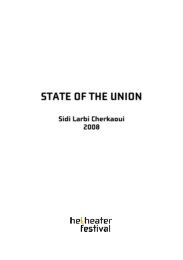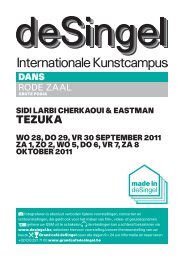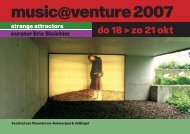Programmaboekje : Wonen in welvaart - deSingel
Programmaboekje : Wonen in welvaart - deSingel
Programmaboekje : Wonen in welvaart - deSingel
Create successful ePaper yourself
Turn your PDF publications into a flip-book with our unique Google optimized e-Paper software.
<strong>in</strong> prosperity’ (comforts, hygiene and functionality). Common<br />
facilities (a social centre, schools, a church, stores,...) are<br />
monumentally and expressively dealt with.<br />
Build<strong>in</strong>g the Model district took more than 10 years. Most of the<br />
common facilities and the family houses, that were supposed to<br />
compensate for the high-rise build<strong>in</strong>gs, weren’t built <strong>in</strong> the end. At<br />
Expo 58 there was only a scale-model.<br />
(research: Jo Braeken and Kar<strong>in</strong>a Van Herck)<br />
7)<br />
Nieuw Sledderlo (1963-1970)<br />
The model of a satellite town<br />
Hous<strong>in</strong>g immigrant workers decently was a po<strong>in</strong>t of particular<br />
<strong>in</strong>terest <strong>in</strong> the sixties. The import of new workforce was necessary<br />
for the further development of the <strong>in</strong>dustry and welfare <strong>in</strong><br />
Flanders.<br />
In 1963 as a consequence of a new establishment of car producer<br />
Ford, the city council of Genk gave an assignment for the design<br />
of a companytown for 150,000 <strong>in</strong>habitants, close to the village<br />
Sledderlo. The Dutch urban developer Van Embden was hired<br />
for this job. He suggested design<strong>in</strong>g a satellite town, an urban<br />
model that was applied by Groupe Alpha <strong>in</strong> Brussels, the Offi ce<br />
des Cités Africa<strong>in</strong>es <strong>in</strong> Congo and even by the NMKL <strong>in</strong> Flanders.<br />
Van Embden concieved the satellite town ‘Nieuw Sledderlo’ as a<br />
comprehensive liv<strong>in</strong>g environment: a comb<strong>in</strong>ation of private and<br />
collective functionalities, of terraced houses and gallery fl ats with<br />
large green areas <strong>in</strong> between.<br />
The archives of ‘Nieuw Sledderlo’ tell the remarkable story of a<br />
hous<strong>in</strong>g model connected to the wav<strong>in</strong>g the coal <strong>in</strong>dustry goodbye<br />
and the welcom<strong>in</strong>g of the new consumer economy <strong>in</strong> the Limburg<br />
Kempen region.<br />
(research: Michael Ryckewaert)<br />
8)<br />
The model houses of the The Farmers’ Wives Association<br />
Promotion of domestic comforts <strong>in</strong> the sixties<br />
When it came to modern comforts <strong>in</strong> the sixties, Belgian homes<br />
didn’t do very well <strong>in</strong> comparison to the European average. In<br />
1961 21% of the Belgian families did not own a vacuum cleaner, a<br />
polisher, a refrigerator, a television set, an electric sew<strong>in</strong>g mach<strong>in</strong>e,<br />
wash<strong>in</strong>g mach<strong>in</strong>e or a dryer. All social structures made an effort<br />
to make up arrears. With <strong>in</strong>fo sessions, they tried to conv<strong>in</strong>ce<br />
their members of the advantages of modern kitchens, bathrooms,<br />
central heat<strong>in</strong>g, etcetera. They were less wildly enthusiastic about<br />
enterta<strong>in</strong>ment technology, like television.<br />
In the countryside the situation was worse than <strong>in</strong> the urbanised<br />
areas. That’s probably why the Farmers’ Wives Association<br />
(Boer<strong>in</strong>nenbond) had extra attention for domestic technology. In<br />
1962 it set up the hous<strong>in</strong>g service that promoted ‘technology at<br />
home’ <strong>in</strong> it’s member’s magaz<strong>in</strong>e, speeches and <strong>in</strong> special booklets.<br />
Every year a model home was selected <strong>in</strong> which all members could<br />
admire the newest comforts facilities.<br />
The way <strong>in</strong> which the Farmers’ Wives Association promoted<br />
comforts <strong>in</strong> the sixties, illustrates that the ‘good dwell<strong>in</strong>g’<br />
approach was soon exchanged for a more consumer-oriented<br />
approach. The results were bound to follow. In the golden sixties<br />
the number of electric devices <strong>in</strong>creased spectacularly.<br />
(research: Els De Vos)<br />
9)<br />
Danilith-Delmulle (1965-1974)<br />
Mass production of homes <strong>in</strong> the private sector<br />
The free market played an important role <strong>in</strong> the domestic comfort<br />
for the masses. After the war a lot of contractors built up big<br />
companies. The fi rm Danilith-Delmulle is a good example of this<br />
trend. It developed a system of prefab. With this system, it built a<br />
large number of homes with<strong>in</strong> the <strong>in</strong>centive system of De Taeye,<br />
<strong>in</strong> the example villages of the Agency for Small Private Property<br />
and the National Hous<strong>in</strong>g Agency and even as a show house of the<br />
Farmers’ Wives Association.<br />
In the end Danilith was especially active on the private market. The<br />
fi rm recommended houses through a market<strong>in</strong>g system <strong>in</strong>volv<strong>in</strong>g<br />
brochures, salesmen and show houses. The <strong>in</strong>crease of purchas<strong>in</strong>g<br />
power made the ideal of an <strong>in</strong>dividual newly built house <strong>in</strong> a green<br />
environment a realistic option for a lot of people. The terracedhouse-model<br />
was exchanged successively for the bungalow, the<br />
villa and the farm-style house.<br />
The Danilith archives tell the story of the shift from a collective to<br />
and <strong>in</strong>dividual concept of welfare and the different models that<br />
were <strong>in</strong>volved.<br />
(research: André Loeckx and Kathy Van Hulle)<br />
14 15
















